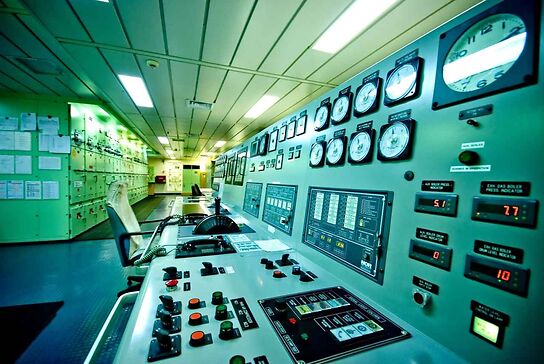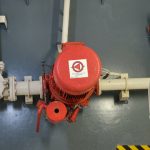A maritime emergency at sea does not come with an alarm, but ship emergency signals and alarms can help us to tackle a crisis or to avoid an emergency efficiently and in the right way.
Emergency signals or alarms on a ship are installed all over the vessel’s various systems and machinery to notify the crew about a dangerous situation that can arise due to different types of emergencies on board ship
Emergency alarms are of audible as well as visual type to ensure that a person can at least listen to the audible alarm when working in an area where seeing a visual alarm is not possible and vice versa.
It is a standard practice in the international maritime industry to have an emergency alarm on the ship for a particular warning which is similar for all seagoing vessels, no matter in which seas they are sailing or to which company they belong to.

This commonness helps the seafarer to know and understand the type of warning/ emergency or ship emergency alarm well and help to tackle the situation faster.
Types of Alarms on Ships
These are the different types of emergency alarms or signal onboard ship that is installed to give audio-visual warnings:
1) General Alarm:
The general emergency alarm on the ship is recognised by 7 short ringing of the bell followed by a long ring or using the ship horn signal of 7 short blasts followed by 1 long blast.
The general alarm in a ship is sounded to make aware the crew on board that an emergency has occurred such as fire, collision, grounding, or a scenario which can lead to abandoning ship etc.
The vessel general alarm system activation point is located in the navigation bridge. Once the general alarm signal onboard is activated; i.e. seven short one long blast (7 short 1 long blast), every ship crew must follow the instruction and duty’ s listed in the muster list and proceed to the designated muster station.

Action to be taken by the crew once ships general alarm is sounded:
· Proceed to the designated muster stations
· Listen to the Public Addressing (PA) system for the type of emergency (usually announced by OOW, Chief officer or Captain) which is leading to the general alarm on a ship
· Once the nature of the emergency is known, the crew member must re-group as per the Squad and take corrective action to tackle the situation as per the muster plan.
2) Fire Alarm on the Ship:
Whenever there is fire detected on the vessel by its crew, he/she should raise the alarm signal onboard ship by pressing the nearest fire switch or by loudly and continuously shouting “FIRE FIRE FIRE”. The fire alarm signal onboard ship is sounded as the continuous ringing of ship’s electrical bell or continuous sounding of ship’s horn.
The fire signal on a ship must be a continuous blast of the whistle or electrical bell for not less than 10 seconds. However, in most of the vessels, the fire signal is rung continuously on the alarm bell.
Once the master decides for the dismissal of the crew from fire stations, the general alarm will be sounded three times followed by three short blasts of the ship’s whistle.
Action to be taken by the crew once ships fire alarm is sounded:
· Proceed to the fire station
· Confirm the location of the fire
· Perform the duty listed in the muster list as per the team assigned
3) Man Overboard Alarm:
There have been many situations when a crew working on ship-side or a passenger in a cruise ship fell in the water at high seas. When a man falls overboard, the man overboard alarm sound signal is activated on the ship.
The MOB alarm sound signal comprises of vessel’s internal alarm bell for 3 long rings to notify the crew onboard, along with 3 long blasts on ship whistle to inform the other ships in the nearby vicinity.
A man overboard signal comprising of light and smoke can also be mounted in the bridge, attached by the side of the lifebuoy, which when thrown in water will emit smoke and light to draw the attention of ship’s crew or other ship around the vicinity.
4) Abandon Ship Alarm:
When the emergency on board ship goes out of hands and ship is no longer safe for the crew on board ship, the signal for abandon ship is given verbally by the master to the station in-charge or the crew on ship’s Personal Addressing (PA) system.
More than six short blasts and one prolonged blast on the ship’s whistle and same signal on the general alarm bell is used as abandon ship alarm or sound signal onboard ship. However, the alarm sounded is similar to a general alarm, and everybody comes to the emergency muster station where the master or his substitute (Chief Officer) gives a verbal order to abandon ship.
Action to be taken by the crew once Abandon ship is announced or sounded:
· Carry your lifejacket/ immersion suit to the designated muster station
· Carry any additional items (Blanket/ ration/ water etc.) as stated under the duty in the muster list
· Avoid taking longer route and routes going from inside the accommodation to the muster station
· Wait for the master’s order for abandon ship
5) Navigational Alarm:
In the navigation bridge, most of the navigational equipment and navigation lights are fitted with failure alarm. If any of these malfunctions, a ship alarm signal on the bridge will be sounded whose details (location, equipment affected, type of problem etc.) will be displayed on the notification screen provided on the bridge navigation panel.
Action to be taken by the crew once the navigational alarm is sounded:
· Check which equipment the alarm is concerning to
· Try to locate the fault due to which the alarm is coming
· Rectify the fault or switch the standby equipment if needed
6) Machinery Space Alarm:
The engine room of the ship is fitted with different machinery which is continuously monitored for its operation using control and monitoring system.
The machinery in the engine room has various safety devices and alarms fitted for safe operation. If anyone of these machinery malfunctions, a common engine room alarm is operated and the problem can be seen in the control room alarm panel which will display the alarm.
Action to be taken by the crew once the engine room alarm is sounded:
· Check which machinery/system the alarm is concerning to
· Try to locate the fault due to which the alarm is coming
· Rectify the fault or switch the standby machinery if needed
7) Machinery Space CO2 Alarm:
The machinery space is fitted with a CO2 fixed fire extinguishing system. The audible and visual alarm for the CO2 fixed firefighting system is entirely different from machinery space alarm and other ship alarm signals for easy reorganisation.
The audible alarms shall be located so as to be audible throughout the protected space with all machinery operating, and the alarms should be distinguished from other audible alarms by adjustment of sound pressure or sound patterns.
The alarm should activate upon opening the release cabinet door which is used to open and release the CO2 bottle banks.
8) Cargo Space CO2 Alarm:
The cargo spaces of the ship are also fitted with a fixed firefighting system which has a different alarm when operated. The audible and visual alarm for the CO2 fixed firefighting system is entirely different from other ship alarms the audible alarm should be distinguished from other alarms in a ship by adjustment of sound pressure or sound patterns.
Action to be taken by the crew once the navigational alarm is sounded:
· Take a head count of the crew
· Ensure the cargo hold is sealed and no crew is inside
· Ensure all the ventilation system for cargo hold are shut
9) Ship Security Alarm System:
As per the SOLAS Chapter XI regulation XI-2/5, all ships shall be provided with a ship security alert system. The Ship Security Alarm system (SSAS) is a silent alarm system sounded in a pirate attack emergency. When the SSAS is activated, no alarm is sounded onboard ship, nor it alerts other vessels in the vicinity. This signal notifies different coastal authorities or competent authority, whose proximity the ship is presently operating via a global satellite system to inform about the piracy.
Different Alarm signals of the vessel are clearly described in the muster list along with the action to be carried out so that all the crew member can perform their duties within no time in an actual emergency. It is of extreme importance that a seafarer must know the different types of alarms in a ship and to recognise which emergency it represents.



Comments are closed